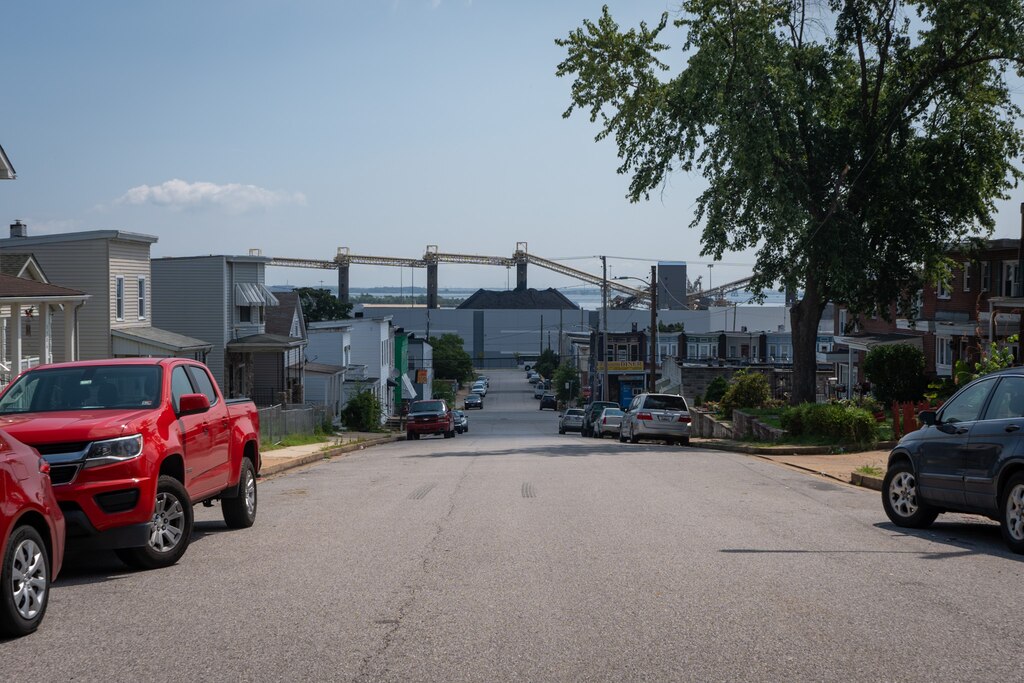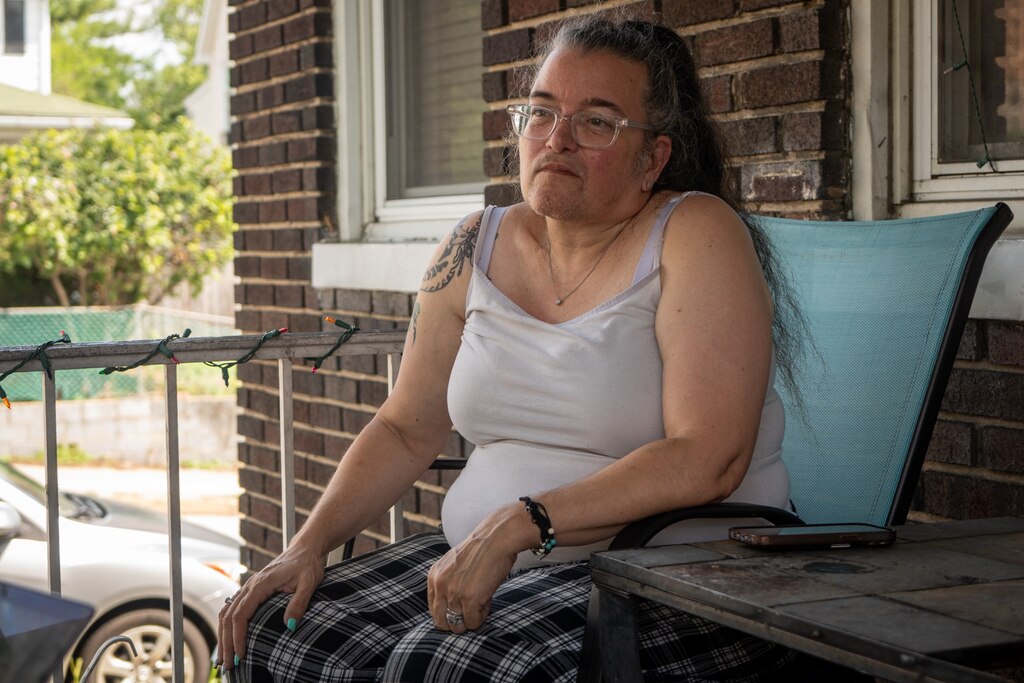“I can’t breathe, I can’t breathe, I can’t breathe,” Charles Hahn, 37, told doctors at Johns Hopkins Hospital in June.
A scan revealed cancerous nodules in his lungs, said his wife, Heather Hahn. Tumors had returned to his liver too. The next time he went to the hospital for heavy nose bleeding, the cancer had metastasized to his brain.
Charles Hahn said his doctors told him that “living in an industrialized area” and coal dust exposure could have caused his cancer.
For the past 15 years, Hahn has lived in Curtis Bay, a South Baltimore neighborhood where his house is a block away from an open-air coal pile.
“I wish they would just take the [coal] plant and go,” said Hahn.

The predominantly Black and Hispanic communities of South Baltimore house the city’s largest number of polluting industries, according to a Johns Hopkins research study. Those communities also have death rates from heart disease, chronic lower respiratory disease and cancer of all kinds that exceed rates in the rest of Baltimore City, the city’s Health Department’s Neighborhood Health Profile data show.
Read More
Homes in Curtis Bay, an area just four city blocks wide and 15 blocks long, are encroached by 70 stationary polluting sources. Residents live near multiple waste incinerators and wastewater treatment plants, oil terminals and gas terminals. Then there are a coal terminal, landfill and asphalt manufacturing plant. Dozens of tractor trailers rattle down two truck routes that pass through the low-income residential area and by its recreational center every hour, spewing diesel particles into the air, according to the South Baltimore Community Land Trust.
Diesel, coal dust and other particles can penetrate deep into human lungs, and can even enter the blood stream, according to Russell Dickerson, professor at the University of Maryland, College Park who studies air pollution. Public health and environmental experts say there is no safe level of exposure.
A bulk of coal dust particles are coarse, according to Dickerson, but some coal gets crushed into finer particles by equipment and during loading.
“The large particles are a nuisance, and an environmental problem, but where there is coarse aerosol there is also fine aerosol, and that is a substantial health threat,” he said, when people inhale the dust.
Coarse particles get stuck in people’s upper airways, causing asthma and chronic obstructive pulmonary disease like bronchitis. Finer particles, “about 1/30 the size of human hair,” can penetrate deep into lungs, causing inflammation that can lead to heart attacks, stroke and even premature death from daily exposure over the years.
Extreme impacts of such chronic exposure include lung cancer, which develops when particles deposit deep into the lungs over time, said Bart Ostro, an epidemiologist at the Air Quality Research Center at the University of California, Davis.
“There’s a causal association between long-term exposure to fine particles and lung cancer. There’s also now some evidence, it’s less strong, but that it might be related to other cancers,” said Ostro.
The World Health Organization came to that conclusion in 2021 and set guidelines around the acceptable level of particulate matter emission.
“For the people that live within half a mile of the coal pile, the coal dust is a major problem, but it is not the only problem,” said Dickerson. “Curtis Bay may be unique in that it has a wide variety of problems, it has a lot of truck traffic and industries and then the massive coal pile, the only one in Baltimore from my knowledge.”
The open-air coal pile resides at a terminal for the rail company CSX, jutting into the Patapsco River, holding roughly 14 million tons of coal every year, according to the South Baltimore Community Land Trust. Some homes are less than half a mile away from the coal.
“We stay in,” said Angie Shaneyfelt, 65, who has lived in Curtis Bay for the last 16 years. “If we do come out, it’ll be more toward the evening time when they’re not really doing too much with the coal … because they operate nine to five.”
CSX claims to be a “good neighbor,” she said. “But a good neighbor to who?”
The coal pier’s operations adhere to “strict regulatory standards,” a CSX spokesperson wrote in a statement. “We regularly invest in technologies and practices that go above and beyond those standards set by federal and state governments.” Those include a water spray system that helps limit how far dust travels when the wind picks up.
Polluting industries have punctuated the Curtis Bay area for over a century. Coal dust is just one of the many pollutants in the air, making it “hard to breathe,” said Shaneyfelt.
The state and federal limits on pollutants are set for individual facilities and don’t take into consideration the compounding pollution that can come from multiple industries in the same area, said Chris Heaney, an associate professor at the Johns Hopkins Bloomberg School of Public Health.
“We certainly can say that there are adverse public health implications from living in a neighborhood like that,” he said.
Chronic exposure to pollutants can eventually trigger issues like strokes and worsen existing health problems like asthma, said Heaney.
Shaneyfelt and her two daughters all have developed asthma over the years living in Curtis Bay and have to get at least one breathing treatment per year, she said.
“It’s hard to breathe ... the coal dust is in the air. It’s so minute that you can’t really see it all the time, but when you breathe it in, you can feel it,” she said.
That kind of air pollution can harm children, too, even before they are born, Heaney said. A parent’s exposure prior to conception and during pregnancy can still make its way into the baby’s bloodstream. The child’s lung and brain development can suffer if they’re breathing in particles as an infant.
Living in a highly industrialized neighborhood can also be mentally burdensome.
“Dealing with the pollution every day, [there are] kind of emotional costs … in the sense of depression and trauma,” said Shaneyfelt.
On Dec. 30, 2021, Shaneyfelt felt a pressure in her living room followed by a boom. She started to go through a mental checklist in her head:
“OK, the electricity is still on, the windows are intact, the house is intact, there is nobody shooting outside. OK, I’m good.”
Then she checked on her kids.
“I looked at my daughter, and she had mentally checked out by the time the boom happened. ... I’m tapping her on her chin, and her sister is looking at me for direction. I had to keep myself together,” she said.
“We’re good. We’re good.”
The boom was a result of a coal silo exploding at the CSX facility, releasing nitrogen oxides, carbon monoxide and sulfur dioxide into the atmosphere, creating a “smell of rotten egg, salt and sulfur,” said Shaneyfelt. It made her gag into her mask when she stepped outside.
Since the explosion, Shaneyfelt has developed anxiety triggered by loud noises, she said.
“On Fourth of July I get true anxiety now because I don’t want to be anywhere near the [fireworks] show,” she said. “I get nervous, like my head is on a pivot ... because it’s not a matter of if it’s gonna happen again, it’s a matter of when is it gonna happen again.”

One study called Curtis Bay a “quintessential example of a human sacrifice zone,” a term coined by Dr. Robert Bullard to describe communities overburdened by polluting industries while “continuing to attract new polluters.”
Residents of these zones are often low-income people of color who are already vulnerable due to lack of health care and stressors such as crime and food insecurity, said Matthew Aubourg, a research associate at the Bloomberg School of Public Health who worked on the study.
Curtis Bay residents have been closely monitoring the industrial sites around them and lodging complaints with the help of environmental justice advocates and experts from Hopkins.
On behalf of the South Baltimore Community Land Trust, the Chesapeake Bay Foundation and Environmental Integrity Project filed a civil rights complaint in May against Baltimore City and its Department of Public Works over their 10-year solid waste management plan. The EPA is now investigating whether the plan disproportionately harms majority Black and Hispanic neighborhoods.
Taylor Lilley, an attorney at the Chesapeake Bay Foundation, said Curtis Bay residents shouldn’t have to be responsible for policing their industrial neighbors.
“There’s a lot of self-reporting,” she said. “There is hope and a need for regulators to engage, step in and participate in this process in a way that takes the burden off of community members to feel like they have to pay such close attention to ensure that something’s being addressed.”





Comments
Welcome to The Banner's subscriber-only commenting community. Please review our community guidelines.